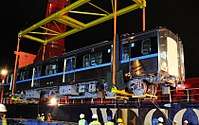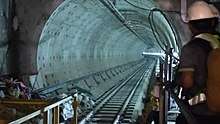Jakarta MRT
 | |
| Overview | |
|---|---|
| Owner | Government of Jakarta |
| Area served | Greater Jakarta |
| Locale | Jakarta, Indonesia |
| Transit type | Rapid transit |
| Number of lines | 2 |
| Number of stations | 13 (North-South line, first phase) |
| Headquarters | Wisma Nusantara, 21st Floor, Jl. M.H. Thamrin 59, Jakarta 10350 - Indonesia - Telp (62)21 3103629, Fax (62) 21 3155846 |
| Website | MRT Jakarta |
| Operation | |
| Operation will start | 1 March 2019 |
| Operator(s) | PT MRT Jakarta |
| Character | Elevated & underground |
| Number of vehicles | 16 six-car trainsets |
| Headway | 5–10 minutes |
| Technical | |
| System length | 16 km (9.9 mi) (first phase) |
| Track gauge | 1,067 mm (3 ft 6 in) |
| Electrification | 1,500 V DC overhead catenary |
The Jakarta Mass Rapid Transit (Jakarta MRT) is a rapid transit system in Jakarta, the capital city of Indonesia.
A groundbreaking ceremony was held on October 10, 2013, with Phase 1 of the project (Lebak Bulus to Hotel Indonesia (HI) Roundabout) to be opened to the public by 2019.[1][2] MRT Jakarta targets to conduct Integration Test & Commissioning in August 2018, followed by an operational test from December 2018 through February 2019, and is expected to be open to the public by March 2019.[3]

As of August 2018, a trial run from Lebak Bulus Station to the Hotel Indonesia Traffic Circle has been completed successfully.[4]
Background
Jakarta is the capital city of Indonesia, harboring 10 million inhabitants, out of 30 million living in Greater Jakarta. It is estimated that over four million residents of the surrounding Greater Jakarta area commute to and from the city each working day. Transport issues have increasingly begun to attract political attention and it has been foreseen that without a major transportation breakthrough, the city will have complete traffic gridlock by 2020.[5]
Since 1980, more than 25 general and special subject studies have been conducted related to possible Mass Rapid Transit (MRT) systems in Jakarta. One of the major reasons for the delays in tackling the problem was the economic and political crises of 1997-99. Before the crisis, a Build-Operate-Transfer (BOT) scheme was considered as part of a new MRT calling for private sector involvement. After the crisis, the plan to rely on a BOT to provide financing proved unfeasible, and the MRT project was again proposed as a government-funded scheme.
Currently, public transportation in Jakarta serves only 56% of commuter trips.[6] This figure urgently needs to be raised, as the city's 9.5% average annual growth rate of motorized vehicles far exceeds the 0.01% increase in road length between 2005 and 2010.[7]
Public transportation now, mainly consists of the TransJakarta bus rapid transit system, Jabodetabek Commuter Railway system, and various types of independent buses, starting from the very small bemo and pickup-truck sized mikrolet, to slightly larger minibuses such as the widely used MetroMini and Kopaja minibuses and full sized city buses. There are also both two and four wheeled taxis.
Lines
The rail-based Jakarta MRT is expected to stretch across over 108 kilometres, including 21.7 km for the North-South Line (from Lebak Bulus to Kampung Bandan) and 87 km for East-West Line (from Balaraja to Cikarang).[8][9]
M1 (North–South line)
| Jakarta MRT North–South MRT line | ||||||||||||||||||||||||||||||||||||||||||||||||||||||||||||||||||||||||||||||||||||||||||||||||||||||||||||||||||||||||||||||||||||||||||||||||||||||||||||||
|---|---|---|---|---|---|---|---|---|---|---|---|---|---|---|---|---|---|---|---|---|---|---|---|---|---|---|---|---|---|---|---|---|---|---|---|---|---|---|---|---|---|---|---|---|---|---|---|---|---|---|---|---|---|---|---|---|---|---|---|---|---|---|---|---|---|---|---|---|---|---|---|---|---|---|---|---|---|---|---|---|---|---|---|---|---|---|---|---|---|---|---|---|---|---|---|---|---|---|---|---|---|---|---|---|---|---|---|---|---|---|---|---|---|---|---|---|---|---|---|---|---|---|---|---|---|---|---|---|---|---|---|---|---|---|---|---|---|---|---|---|---|---|---|---|---|---|---|---|---|---|---|---|---|---|---|---|---|---|
| ||||||||||||||||||||||||||||||||||||||||||||||||||||||||||||||||||||||||||||||||||||||||||||||||||||||||||||||||||||||||||||||||||||||||||||||||||||||||||||||
The North–South line will be built in two phases. After completion of MRT Phase I and II, MRT together with TransJakarta are predicted to serve 60 percent total trips made by Jakartans. The northern part of Line 1 (Phase II as well as part of Phase I) follows the route of the currently existing TransJakarta Line 1.
Phase I
This will connect Lebak Bulus to Bundaran HI along 15.5 km including 13 stations (7 elevated stations and 6 underground stations). The Indonesian Ministry of Transport approved this plan in September 2010 and invited tenders. This section is now expected to be completed in March 2019.[1][10]The first phase is 15.7 kilometres (9.8 mi) long from Lebak Bulus to Bundaran HI. The construction project began in 2013, and is expected to be opened by 2019[1] and to serve 212,000 passengers per day. This expected capacity may be maxed out to 960,000 per day. The 15.7 km distance expected to be covered in under 30 minutes.[11] The line has six underground and seven elevated stations:[12]
- Underground stations
- Bundaran Hotel Indonesia
- Dukuh Atas connections to K3 ARS L2
- Setiabudi
- Bendungan Hilir
- Istora
- Senayan
- Elevated stations
- Sisingamangaraja
- Blok M
- Blok A
- Haji Nawi
- Cipete Raya
- Fatmawati
- Lebak Bulus
Phase II
This will extend the North–South line from Bundaran HI to Kampung Bandan (7 underground stations and 1 ground-level station), and is planned to open after Phase I in operation (accelerated from 2020 as the original plan[13]).[14] Construction of this part is expected to start by the end of 2018, and will cost US$ 1.48 billion.[15][16]
M2 (East–West line)
| Jakarta MRT East-West MRT line | ||||||||||||||||||||||||||||||||||||||||||||||||||||||||||||||||||||||||||||||||||||||||||||||||||||||||||||||||||||||||||||||||||||||||||||||||
|---|---|---|---|---|---|---|---|---|---|---|---|---|---|---|---|---|---|---|---|---|---|---|---|---|---|---|---|---|---|---|---|---|---|---|---|---|---|---|---|---|---|---|---|---|---|---|---|---|---|---|---|---|---|---|---|---|---|---|---|---|---|---|---|---|---|---|---|---|---|---|---|---|---|---|---|---|---|---|---|---|---|---|---|---|---|---|---|---|---|---|---|---|---|---|---|---|---|---|---|---|---|---|---|---|---|---|---|---|---|---|---|---|---|---|---|---|---|---|---|---|---|---|---|---|---|---|---|---|---|---|---|---|---|---|---|---|---|---|---|---|---|---|---|---|
| ||||||||||||||||||||||||||||||||||||||||||||||||||||||||||||||||||||||||||||||||||||||||||||||||||||||||||||||||||||||||||||||||||||||||||||||||
A second line is planned to run east-west, to connect Cikarang (in Bekasi) and Balaraja (in Tangerang) with Jakarta city center. Covering a distance of 87 kilometers, this line will cross Ujung Menteng and Rawa Bebek areas on the border between Bekasi and East Jakarta. This project is currently in the pre-feasibility study phase.[8] The line is targeted to operate in 2024.
Construction progress

Construction of the first phase was funded through a loan by the Japan Bank for International Cooperation (JBIC), now merged into the Japan International Cooperation Agency (JICA). The loan number IP is 536 (signed November 2006) for engineering services. The engineering services loan is a pre-construction loan to prepare the construction phase. It consists of:
- Basic Design package, managed by the DGR (Directorate General of Railways, Ministry of Transport)
- Management and Operation package, managed by the Bappeda (Jakarta Regional Planning Board)
- Construction assistance in tender, managed by the PT MRT Jakarta
On 1 June 2013, the first three civil contracts for the 9.2 km underground section were signed. The three contracts were won by two separate consortium of Japanese and Indonesian companies.[17] Three civil engineering contracts for the elevated section were signed in the third quarter of 2013. Construction work began October 2013.[18]
Tunnel boring was finished on 23 February 2017, and about 83 percent of tunnel construction has been completed. On 14 March 2017, the first phase—which include the construction of tunnel and upper deck, has met the target completion date.[19]
As October, 2017 the construction of both elevated and underground line sections has been completed.[20] The progress of the construction process currently being undertaken by MRT Jakarta as a whole has reached 86.17 percent per 26 November 2017. In the construction of elevated section of elevation along Lebak Bulus to Senayan has reached 78.37%, while in the underground passage section (Underground Section) from Senayan to Bundaran HI has reached 93.95 percent.[3] The second phase of the project has not commenced yet, and there is a plan to extend the line eastward from Kampung Bandan to Ancol Timur.[21]
PT Mass Rapid Transit Jakarta
PT Mass Rapid Transit Jakarta (PT MRTJ) is a limited liability (Perseroan Terbatas) company founded by the Jakarta Provincial Government. Its establishment was approved by the provincial parliament (DPRD) on 10 June 2008 and final establishment was by notary act on 17 June 2008. Its purpose is to operate the Jakarta MRT System. 99% of the shares are owned by the Jakarta Provincial Government and 1% PT Pasar Jaya (another Jakarta Regional-Government-Owned Company). PT MRTJ is classed as a Regional-Government-Owned-Company (Badan Usaha Milik Daerah-BUMD). The BUMD form for PT MRTJ is designed not to create profits for the shareholders, but instead to create flexibility in accessing alternative financing, which would otherwise be impossible if the company was directly part of the government. With this, the cost of tickets sold to clients will be reduced, with some operational costs being subsidised by other sources. The BUMD form also ensures transparency and accountability through the shareholders' General Meeting, Decision Making and Reporting System which will be publicly available.
Rolling stock
Jakarta MRT will use electric multiple units produced by Sumitomo Corporation and Nippon Sharyo, Japan. Contract between PT MRT Jakarta and Sumitomo Corporation was signed on 3 March 2015.[22] The trains that will be operated by Jakarta MRT will use automatic train operation.[23] It will also use the communications-based train control (CBTC) signalling system.[24]
See also
References
- 1 2 3 "MTR Academy Signs Memorandum of Understanding with MRT Jakarta to Support Development of Indonesia's First Mass Transit System" (PDF). MTR. 28 April 2017.
- ↑ "Jokowi leads MRT ground-breaking ceremony". October 10, 2013.
- 1 2 "Inilah Progres Terbaru Konstruksi, Armada dan Rekrutmen MRT Jakarta". December 1, 2017.
- ↑ "Jakarta MRT has second successful trial run". The Jakarta Post. Retrieved 23 August 2018.
- ↑
- ↑ https://sustainabledevelopment.un.org/content/dsd/susdevtopics/sdt_pdfs/meetings2010/egm0310/presentation_Rini.pdf
- ↑ "United Nations Forum On Climate Change Mitigation, Fuel Economy And Sustainable Development Of Urban Transport" (PDF). Urban Public Transport System in Jakarta. Retrieved 2015-09-20.
- 1 2 Agnes Rita Sulistyawati; Mukhamad Kurniawan (26 December 2015). "Persiapan Studi Jalur MRT Timur-Barat Sudah Dimulai". Kompas (in Indonesian).
- ↑ Extensive details are available at the PT Mass Rapid Transit project website
- ↑ "Urban rail news in brief". Railway Gazette International. 2010-10-03. Retrieved 2010-10-05.
- ↑ "MRT construction likely to disrupt public utility networks". October 7, 2011.
- ↑ "Stasiun dan Fasilitas" (in Indonesian). Retrieved 3 February 2018.
- ↑ MRT Development Accelerated
- ↑ MRT Takes Small Step Forward as Contractors Approved - The Jakarta Globe
- ↑ "Pembangunan MRT Fase II Dimulai Akhir 2018". Kompas. Retrieved 11 October 2018.
- ↑ "Construction on MRT's Sarinah-Kampung Bandan route to begin in three months". The Jakarta Post. Retrieved 11 October 2018.
- ↑ 'Jakarta metro civil works contracts signed', Rail Journal, 13 June 2013.
- ↑ "Jakarta metro contracts signed". Railway Gazette. 13 June 2013.
- ↑ "Pengeboran Jalur "Underground" di MRT Fase I Sudah Selesai". March 14, 2017.
- ↑ "MRT Jakarta focuses on constructing stations, depot". The Jakarta Post. Retrieved 1 December 2017.
- ↑ Deti Mega Purnamasari (March 14, 2017). "Ajak Tinjau MRT, Plt Gubernur DKI Sebut DPRD Beri Respons Positif".
- ↑ "Kontrak Rolling Stock Proyek MRT Jakarta Ditandatangani" (PDF) (Press release) (in Indonesian). PT MRT Jakarta. 3 March 2015. Archived from the original (PDF) on 16 March 2015.
- ↑ Rudi, Alsadad (3 March 2015). "Kereta MRT Jakarta Bisa Beroperasi secara Otomatis". Kompas (in Indonesian). Retrieved 26 August 2017.
- ↑ Akhir, Dani Jumadil (3 August 2017). "Canggih! Proyek MRT Jakarta Gunakan Sistem Persinyalan CBTC, Termutakhir di Dunia". Okezone.com (in Indonesian). Retrieved 26 August 2017.